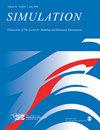结合功能-行为-结构框架的基于主体的模型的开发,使系统工程设计过程评估成为可能
IF 2
4区 工程技术
Q4 COMPUTER SCIENCE, INTERDISCIPLINARY APPLICATIONS
Simulation-Transactions of the Society for Modeling and Simulation International
Pub Date : 2023-11-04
DOI:10.1177/00375497231207877
引用次数: 0
摘要
开发任何流程的一个重要步骤是评估。评估确保过程影响有效性、效率或其他设计的度量标准。没有评估,过程必须完全依赖于形成它们的理论、公理和/或启发。以结果或目标为基础的评价在观察预期影响是否实现方面特别有用。由于系统设计工作持续时间长、成本高、特定于组织/团队以及特定于环境/上下文,系统和设计工程为结果评估提出了问题。这些特点使得在相同条件下使用不同工艺重复相同的工作变得困难,如果不是不可能的话。虽然在实际应用程序中对评估过程进行比较可能是不可行的,但使用捕获系统设计行为的代理对过程进行模拟可能会产生支持假设的发现。本文探讨了使用基于智能体的建模和仿真来比较一个简单的设计问题的伪瀑布和伪敏捷工程过程。设计的功能-行为-结构(FBS)模型与FBS研究的经验数据一起使用伪瀑布和伪敏捷工程流程来检查两人设计团队的性能。这个练习的结果显示了在完成设计的总时间内,类似敏捷的过程可能具有的优势。本文章由计算机程序翻译,如有差异,请以英文原文为准。
Development of an agent-based model incorporating Function–Behavior–Structure framework to enable systems engineering design process evaluation
An important step in the development of any process is evaluation. Evaluation ensures that the process affects effectiveness, efficiency, or other metrics as designed. Without evaluation, processes must stand solely on the theories, axioms, and/or heuristics that formed them. Outcome or objectives-based evaluations are especially useful in seeing if the expected impact is realized. Systems and design engineering present problems for outcome evaluations due to system design efforts being long in duration, expensive, organization/team specific, and environment/context specific. These characteristics make repeating the same effort under the same conditions using different processes difficult, if not impossible. While a comparison of processes for evaluation in a real application may not be feasible, a simulation of the processes with agents that capture system design behaviors may produce findings to support hypotheses. This paper examines the use of agent-based modeling and simulation to compare pseudo-waterfall and pseudo-agile engineering processes for a simple design problem. The Function–Behavior–Structure (FBS) model of design is used along with empirical data from FBS studies to examine the performance of a two-person design team using pseudo-waterfall and pseudo-agile engineering processes. The results of this exercise show possible advantages of agile-like processes in total time to complete the design.
求助全文
通过发布文献求助,成功后即可免费获取论文全文。
去求助
来源期刊
CiteScore
3.50
自引率
31.20%
发文量
60
审稿时长
3 months
期刊介绍:
SIMULATION is a peer-reviewed journal, which covers subjects including the modelling and simulation of: computer networking and communications, high performance computers, real-time systems, mobile and intelligent agents, simulation software, and language design, system engineering and design, aerospace, traffic systems, microelectronics, robotics, mechatronics, and air traffic and chemistry, physics, biology, medicine, biomedicine, sociology, and cognition.

 求助内容:
求助内容: 应助结果提醒方式:
应助结果提醒方式:


